Wind Farm Layout Upgrade Optimization
Abstract
:1. Introduction
2. Horns Rev 1 and Literature Review
- Three years of detailed wind resource assessment data taken prior to the installation are publicly available [14].
- Detailed operational measurements are also publicly available, e.g., [15].
- The installed capacity is 160 MW, which made it the world’s largest offshore wind farm when installed and for several years thereafter.
- Since installed in 2002 it has produced more than 9 TW-hr [16].
3. WFLUO Methodology
3.1. Proposed Upgraded Layouts
3.2. Wake Model and Interference Calculations
3.3. Commercial Turbines and AEP Calculations
3.4. Hub Height Variation
3.5. Modified Simple Cost Model
- The Total Cost of a wind farm is a combination of the Capital Cost, CC, and the Operation and Maintenance cost, O&M, CO&M. It was assumed that, fractionally, CC = 0.75, while CO&M = 0.25 [10].
- CC in turn is subdivided into the total turbine cost, Cturbine = 0.329 CC, and the remainder, 0.671 CC, is the Financial and Balance of System costs, CF&B [46].
- CF&B depends mainly on the farm area, as the number of turbines is fixed for each layout. Accordingly, the foundation and the other infrastructure costs were assumed fixed for each layout and. In other words, if the turbines were added within the original farm area, the added CC would comprise only Cturbine while CF&B was considered unchanged.
- The cost of a 1.0 MW turbine installed at the corresponding Hmin, according to its rotor diameter, was taken as the Unit Cost Index, UCI. The corresponding capital and total costs were denoted Capital Cost Index, CCI, and Total Cost Index, TCI, respectively.
3.6. Optimization
- The turbines must lie between the extended farm area and the original farm area, as shown in Figure 3.
4. Results and Discussion
- There is a wide range of feasible optimum upgrades providing a useful trade-off between AEP and COE.
- The single turbine internal layouts produced a range of NAEP from 1.90 to 2.60 with a NTCI from 1.47 to 2.87, depending on the turbine model.
- The single turbine external layouts gave NAEP from 2.23 to 3.36 with a NTCI from 3.81 to 7.20, depending on the turbine model.
- The internal layouts produced cheap additional AEP if small turbines were used. The added AEP increases as the turbine size increases, but at a higher rate in the added cost. The reason is the limited wind resources which causes the increase in AEP to reduce as the turbine size (and hence the cost) increases.
- As expected, the external layouts added more AEP than the internal ones; however, this increase in AEP is accompanied with very high cost as a consequence of adding area to the farm.
- All layouts have the same trends in AEP and TCI (qualitatively); however, the external grid ones have magnified scales, especially for the cost.
- All layouts confirm the superiority of using turbines with relatively large diameter and relatively low rated speed (turbines number 2, 1, 6, 5, 4, and 3) than the opposite (turbines number 15, 8, 17, 16, and 12). This finding matches that in our previous research [26] and with others in the literature, e.g., [51].
- The NCOEI for the internal layouts are usually close to unity, which means that the added AEP increases comparably to the TCI.
- The unstructured layouts provided almost the same AEP as the external ones with surprisingly much less cost (the NCOEI was close to that of the internal grid layouts). The reason relates to the greater flexibility in locating the turbines which reduces the need for using higher heights to minimize the wake interference. As shown in Figure 9 and Figure 10, a wider range of CH selections were obtained for unstructured layouts compared with the grid ones. The use of relatively low heights resulted in dramatic decrease in cost.
- The turbines were located more frequently close to the corners. This is understandable because these locations have the least effect on the original turbines.
- In maximizing AEP, more than half the turbines were installed at low and medium heights. This means that properly locating the turbines was much more important than having higher heights in order to maximize the AEP. Accordingly, the cost was reduced dramatically for the unstructured layouts compared with the external grid layouts, Figure 8 and Figure 9.
5. Conclusions
- Existing middle-aged wind farms can be feasibly upgraded to increase the energy production by adding new turbines, while keeping the cost of energy in reasonable range.
- Wind farm layout upgrade for offshore farms is recommended if it is done within the original farm area and infrastructure. In this case, a significant increase in the energy production can be achieved while keeping the cost of energy in a reasonable range.
- Having a range of commercial turbines for selection as well as allowing variation in height is a powerful tool in the optimization of the wind farm layout upgrade.
- If the added turbines are to be installed outside the original farm area, the unstructured layout has a clear advantage in cost reduction compared to the grid one. It can produce the same output with much less cost.
- By considering more than one objective function, a wide band of feasible optimum layouts is obtained which provide a trade-off between energy production and cost of energy.
- Among commercial turbines having the same rated power, the priority in selection should be biased towards the turbines with larger diameter and lower rated speed.
- Using a population size equal to double the number of variables and allowing the evolution over 100 generations is enough to get reasonable results in the present optimization problem.
- An approximate formula is given to compare the turbines available for the upgrade, from the cost of energy point of view, based on rated power and diameter.
6. Limitations and Avenues for Future Research
- The cost model was simplified in order to be expressed only in terms of turbines’ rated power and hub height. Consequently, some other factors were not considered, such as: rotor diameter and transportation cost.
- The simple wake models not able to assess the fatigue and other loads associated with multiple turbines, which may well need to be considered in layout optimization.
- The expected effects of wake meandering on wake interference across large farms were not implemented.
- It was assumed that all turbines are available and can be installed at any height within the chosen limits. However, there are associated financial and technical difficulties that were not considered in the selection or in the cost model.
Author Contributions
Funding
Acknowledgments
Conflicts of Interest
List of Acronyms
| AEP | Annual Energy Production |
| AF | Area Factor |
| CCI | Capital Cost Index |
| COAEI | Cost Of Added Energy Index |
| COE | Cost Of Energy |
| COTEI | Cost Of Total Energy Index |
| GA | Genetic Algorithm |
| NAEP | Normalized Annual Energy Production |
| NCOEI | Normalized Cost Of Energy |
| NTCI | Normalized Total Cost Index |
| PS | Population Size |
| TCI | Total Cost Index |
| UCI | Unit Cost Index |
| WFLO | Wind Farm Layout Optimization |
| WFLUO | Wind Farm Layout Upgrade Optimization |
References
- IRENA. Renewable Power Generation Costs in 2017; International Renewable Energy Agency: Abu Dhabi, UAE, 2018; Available online: https://www.irena.org/-/media/Files/IRENA/Agency/Publication/2018/Jan/IRENA_2017_Power_Costs_2018.pdf (accessed on 3 March 2019).
- Global Wind Statistics 2017. Global Wind Energy Council (GWEC), February 2018. Available online: http://gwec.net/wp-content/uploads/vip/GWEC_PRstats2017_EN-003_FINAL.pdf (accessed on 3 March 2019).
- World Energy Perspectives 2016. EXECUTIVE SUMMARY. World Energy Council. Available online: https://www.worldenergy.org/wp-content/uploads/2016/09/Resilience_Managing-cyber-risks_Exec-summary.pdf (accessed on 3 March 2019).
- The shift Project Data Portal. Available online: http://www.tsp-data-portal.org/all-datasets (accessed on 3 March 2019).
- BP Statistical Review of World Energy. June 2017. Available online: https://www.bp.com/content/dam/bp-country/de_ch/PDF/bp-statistical-review-of-world-energy-2017-full-report.pdf (accessed on 3 March 2019).
- Environmental Impacts of Wind Power. Available online: https://www.ucsusa.org/clean-energy/renewable-energy/environmental-impacts-wind-power (accessed on 3 March 2019).
- Mosetti, G.; Poloni, C.; Diviacco, B. Optimization of wind turbine positioning in large wind farms by means of a genetic algorithm. J. Wind Eng. Ind. Aerodyn. 1994, 51, 105–116. [Google Scholar] [CrossRef]
- 2014 Wind Technologies Market Report; US Department of Energy, Wind and Water Power Technologies Office: Berkeley, CA, USA, 2015.
- Lindvig, K. The installation and servicing of offshore wind farms. In European Forum for Renewable Energy Sources; A2SEA A/S: Fredericia, Denmark, 2010. [Google Scholar]
- Saraswati, N.; Stehly, T.; Dewan, A.; Delmarre, A. Operation and Maintenance Map of U.S. Offshore Wind Farms; ECN-E--17-028. The Netherlands, November 2017. Available online: https://publicaties.ecn.nl/PdfFetch.aspx?nr=ECN-E--17-028 (accessed on 3 March 2019).
- Wind Farm Lifecycle. Available online: https://canwea.ca/communities/planning-a-wind-farm/ (accessed on 3 March 2019).
- Hou, P.; Enevoldsen, P.; Hu, W.; Chen, C.; Chen, Z. Offshore wind farm repowering optimization. Appl. Energy 2017, 208, 834–844. [Google Scholar] [CrossRef]
- Topham, E.; McMillan, D. Sustainable decommissioning of an offshore wind farm. Renew. Energy 2017, 102, 470–480. [Google Scholar] [CrossRef]
- Sommer, A.; Hansen, K. Wind Resources at Horns Rev; Technical Report, Report No. D-160949; Tech-Wise A/S: Fredericia, Denmark, December 2002; p. 69. [Google Scholar]
- Jensen, L.; Mørch, C.; Sørensen, P.; Svendsen, K.H. Wake Measurements from the Horns Rev Wind Farm; EWEC: London, UK, 2004; pp. 22–25. [Google Scholar]
- Overview of the Energy Sector. Available online: https://ens.dk/en/our-services/statistics-data-key-figures-and-energy-maps/overview-energy-sector (accessed on 3 March 2019).
- Barthelmie, R.; Hansen, K.; Frandsen, S.; Rathmann, O.; Schepers, J.; Schlez, W.; Phillips, J.; Rados, K.; Zervos, A.; Politis, E.; et al. Modelling and measuring flow and wind turbine wakes in large wind farms offshore. Wind Energy 2009, 12, 431–444. [Google Scholar] [CrossRef]
- Rathmann, O.; Barthelmie, R.; Frandsen, S. Wind turbine wake model for wind farm power production. In Proceedings of the European Wind Energy Conference, Athens, Greece, 27 February–2 March 2006. [Google Scholar]
- Barthelmie, R.; Pryor, S.; Frandsen, S.; Hansen, K.; Schepers, J.; Rados, K.; Schlez, W.; Neubert, A.; Jensen, L.; Neckelmann, S. Quantifying the impact of wind turbine wakes on power output at offshore wind farms. J. Atmos. Ocean. Technol. 2010, 27, 1302–1317. [Google Scholar] [CrossRef]
- Frandsen, S.; Barthelmie, R.; Pryor, S.; Rathmann, O.; Larsen, S.; Højstrup, J.; Thøgersen, M. Analytical modelling of wind speed deficit in large offshore wind farms. Wind Energy 2006, 9, 39–53. [Google Scholar] [CrossRef]
- Frandsen, S.; Rathmann, O.; Barthelmie, R.; Jørgensen, H.; Badger, J.; Hansen, K.; Ott, S.; Rethore, P.; Larsen, S.; Jensen, L. The making of a second-generation wind farm efficiency model complex. Wind Energy 2009, 12, 445–458. [Google Scholar] [CrossRef]
- Beaucage, P.; Robinson, N.; Brower, M.; Alonge, C. Overview of six commercial and research wake models for large offshore wind farms. In Proceedings of the European Wind Energy Conference & Exhibition; European Wind Energy Association (EWEA 2012), Copenhagen, Denmark, 16–19 April 2012. [Google Scholar]
- Rivas, R.; Clausen, J.; Hansen, K.; Jensen, L. Solving the turbine positioning problem for large offshore wind farms by simulated annealing. Wind Eng. 2009, 33, 287–297. [Google Scholar] [CrossRef]
- Vezyris, C. Offshore Wind Farm Optimization Investigation of Unconventional and Random Layouts. Master’s Thesis, TU Delft, Delft, The Netherlands, 2012. [Google Scholar]
- Park, J.; Law, K. Layout optimization for maximizing wind farm power production using sequential convex programming. Appl. Energy 2015, 151, 320–334. [Google Scholar] [CrossRef]
- Abdulrahman, M.; Wood, D. Investigating the power-COE trade-off for wind farm layout optimization considering commercial turbine selection and hub height variation. Renew. Energy 2017, 102, 267–516. [Google Scholar] [CrossRef]
- Feng, J.; Shen, W.Z. Modelling wind for wind farm layout optimization using joint distribution of wind speed and wind direction. Energies 2015, 8, 3075–3092. [Google Scholar] [CrossRef]
- Herbert-Acero, J.-F.; Franco-Acevedo, J.-R.; Valenzuela-Rendon, M.; Probst-Oleszewski, O. Linear wind farm layout optimization through computational intelligence. In Proceedings of the 8th Mexican International Conference on Artificial Intelligence, Guanajuato, Mexico, 9–13 November 2009; pp. 692–703. [Google Scholar]
- Tesauro, A.; Réthoré, P.-E.; Larsen, G. State of the art of wind farm optimization. In Proceedings of the European Wind Energy Conference & Exhibition; European Wind Energy Association (EWEA 2012), Copenhagen, Denmark, 16–19 April 2012. [Google Scholar]
- Chowdhury, S.; Zhang, J.; Messac, A.; Castillo, L. Optimizing the arrangement and the selection of turbines for wind farms subject to varying wind conditions. Renew. Energy 2013, 52, 273–282. [Google Scholar] [CrossRef]
- Chen, Y.; Li, H.; Jin, K.; Song, Q. Wind farm layout optimization using genetic algorithm with different hub height wind turbines. Energy Convers. Manag. 2013, 70, 56–65. [Google Scholar] [CrossRef]
- Sørensen, T.; Nielsen, P.; Thøgersen, M.L. Recalibrating Wind Turbine Wake Model Parameters—Validating the Wake Model Performance for Large Offshore Wind Farms; EMD International A/S: Aalborg, Denmark, 2006. [Google Scholar]
- Sørensen, T.; Thøgersen, M.; Nielsen, P.; Jernesvej, N. Adapting and Calibration of Existing Wake Models to Meet the Conditions Inside Offshore Wind Farms; EMD International A/S: Aalborg, Denmark, 2008. [Google Scholar]
- Barthelmie, R.; Folkerts, L.; Larsen, G.; Rados, K.; Pryor, S.; Frandsen, S.; Lange, B.; Schepers, G. Comparison of wake model simulations with offshore wind turbine wake profiles measured by SODAR. J. Atmos. Ocean. Technol. 2006, 23, 888–901. [Google Scholar] [CrossRef]
- Jensen, N. A Note on Wind Generator Interaction. Risø-M-2411; Risø National Laboratory: Roskilde, Denmark, 1983. [Google Scholar]
- Katic, I.; Hojstrup, J.; Jensen, N. A simple model for cluster efficiency. In Proceedings of the European Wind Energy Association Conference and Exhibition, Rome, Italy, 7–9 October 1986; pp. 407–410. [Google Scholar]
- Frandsen, S. On the wind speed reduction in the center of large clusters of wind turbines. J. Wind Eng. Ind. Aerodyn. 1992, 39, 251–265. [Google Scholar] [CrossRef]
- Oke, T.R. Boundary Layer Climates, 2nd ed.; Methuen: London, UK, 1987. [Google Scholar]
- Wieringa, J. Updating the davenport roughness classification. J. Wind Eng. Ind. Aerodyn. 1992, 41, 357–368. [Google Scholar] [CrossRef]
- Port-Agel, F.; Wu, Y.; Chen, C. A numerical study of the effects of wind direction on turbine wakes and power losses in a large wind farm. Energies 2013, 6, 5297–5313. [Google Scholar] [CrossRef]
- Vasel-Be-Hagh, A.; Archer, C. Wind farm hub height optimization. Appl. Energy 2017, 195, 905–921. [Google Scholar] [CrossRef]
- Chen, K.; Song, M.X.; Zhang, X.; Wang, S.F. Wind turbine layout optimization with multiple hub height wind turbines using greedy algorithm. Renew. Energy 2016, 96, 676–686. [Google Scholar] [CrossRef]
- Horns Rev 3. Technical Project Description for the Large-Scale Offshore Wind Farm (400 MW) at Horns Rev 3. 43. Document no. 13/93461-2897, 28.04.2014. Energinet/DK: Erritsø, Denmark. Available online: https://ens.dk/sites/ens.dk/files/Vindenergi/horns_rev_3_offshore_technical_project_description_28.04.201.pdf (accessed on 3 March 2019).
- World’s Tallest Wind Turbines Built in Germany. Available online: https://electrek.co/2017/11/02/worlds-tallest-wind-turbine-built-in-germany/ (accessed on 3 March 2019).
- Oteri, F. An Overview of Existing Wind Energy Ordinances; National Renewable Energy Laboratory Technical Report, NREL/TP-500-44439; National Renewable Energy Laboratory: Lakewood, CO, USA, 2008. [Google Scholar]
- Moné, C.; Stehly, T.; Maples, B.; Settle, E. 2014 Cost of Wind Energy Review; National Renewable Energy Laboratory (NREL): Lakewood, CO, USA, 2015. [Google Scholar]
- Samorani, M. The Wind Farm Layout Optimization Problem; Technical Report; Leeds School of Business, University of Colorado: Boulder, CO, USA, 2010. [Google Scholar]
- Khan, S.; Rehman, S. Iterative non-deterministic algorithms in on-shore wind farm design: A brief survey. Renew. Sustain. Energy Rev. 2013, 19, 370–384. [Google Scholar] [CrossRef]
- Roeva, O.; Fidanova, S.; Paprzycki, M. Influence of the population size on the genetic algorithm performance in case of cultivation process modelling. In Proceedings of the 2013 Federated Conference on Computer Science and Information Systems, Kraków, Poland, 8–11 September 2013; pp. 371–376. [Google Scholar]
- © 1994-2019 The MathWorks, Inc. Available online: https://www.mathworks.com/help/gads/genetic-algorithm.html (accessed on 3 March 2019).
- Rehman, S.; Khan, S.A. Fuzzy logic based multi-criteria wind turbine selection strategy—A case study of Qassim, Saudi Arabia. Energies 2016, 9, 872. [Google Scholar] [CrossRef]



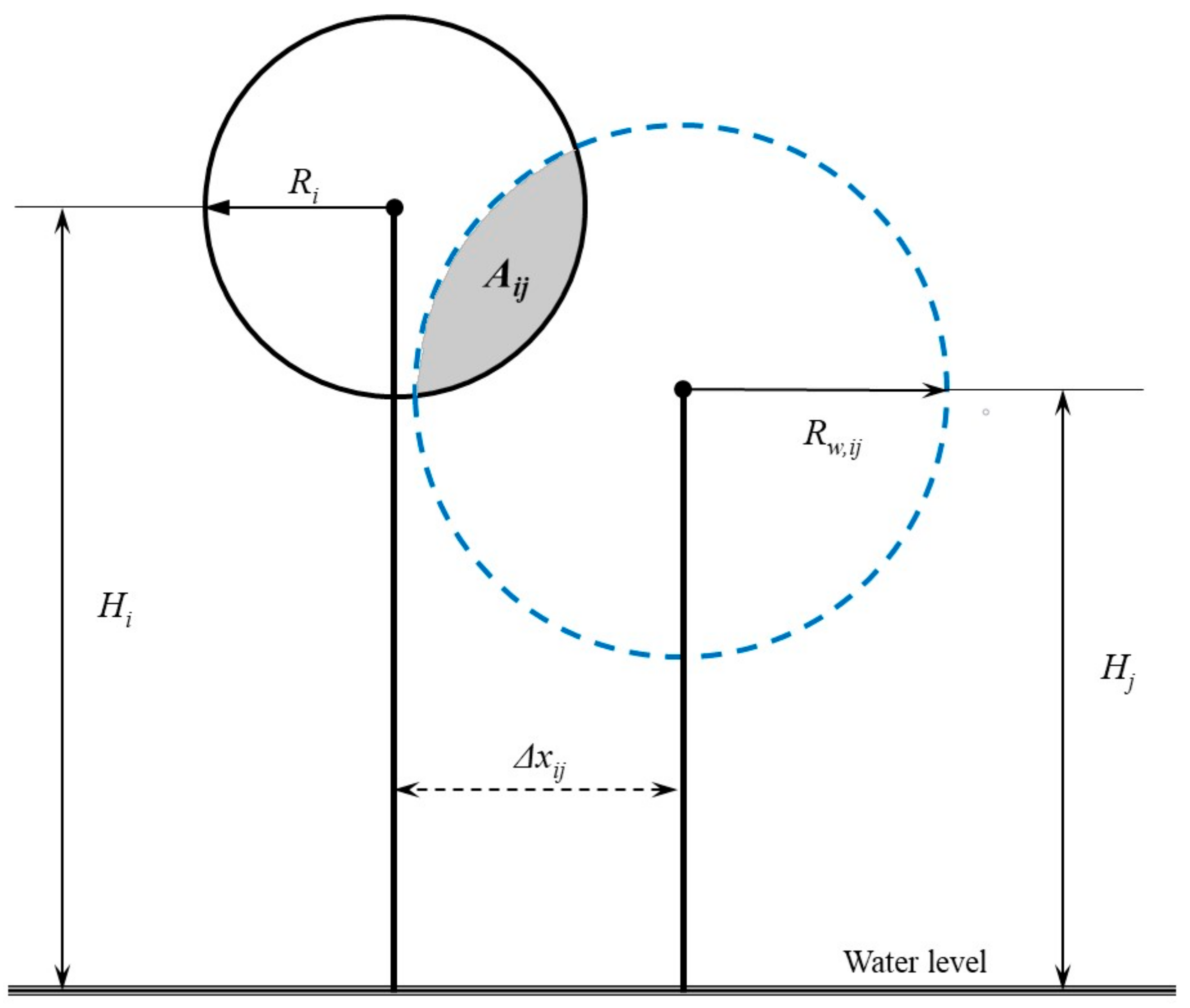
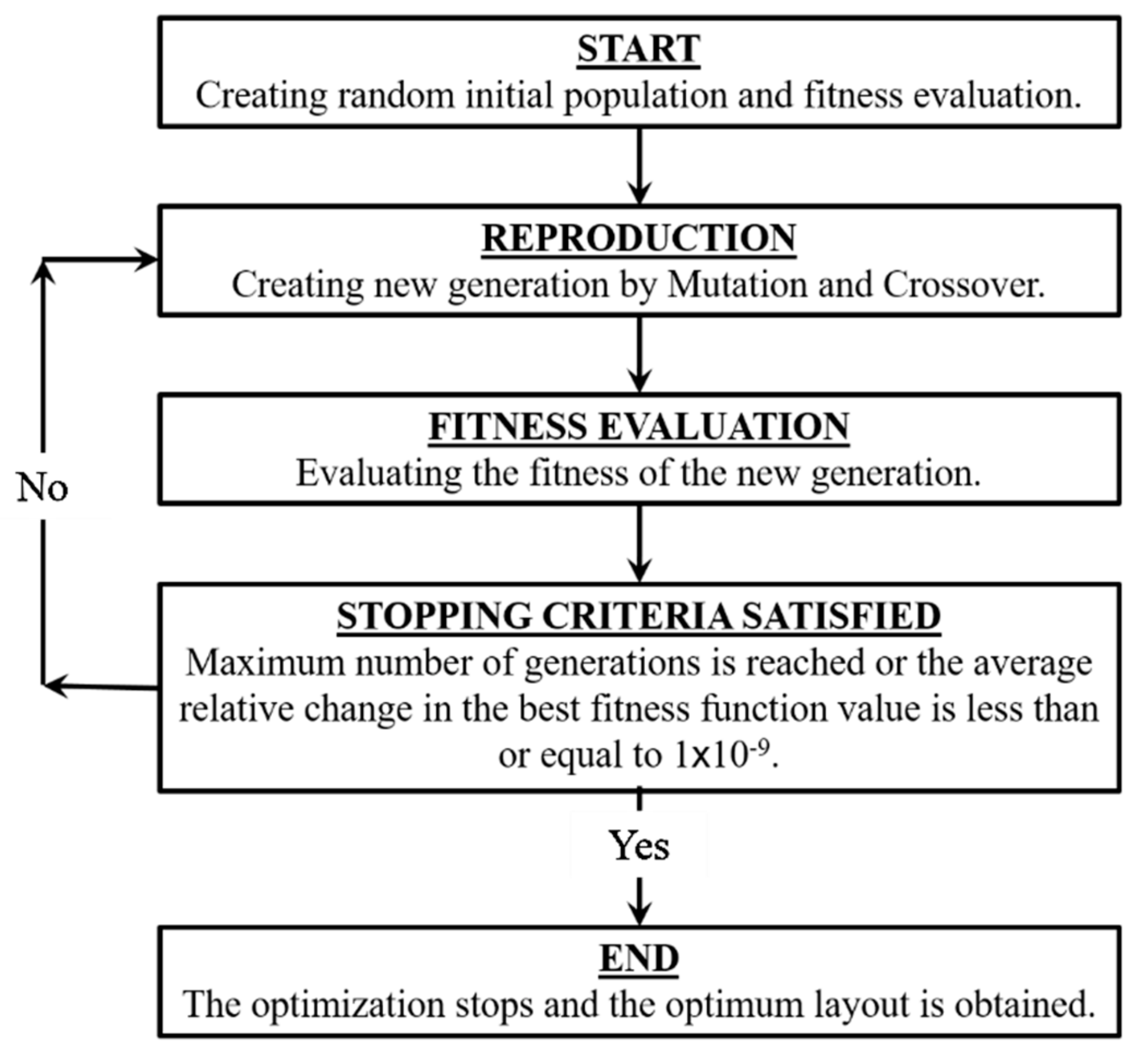

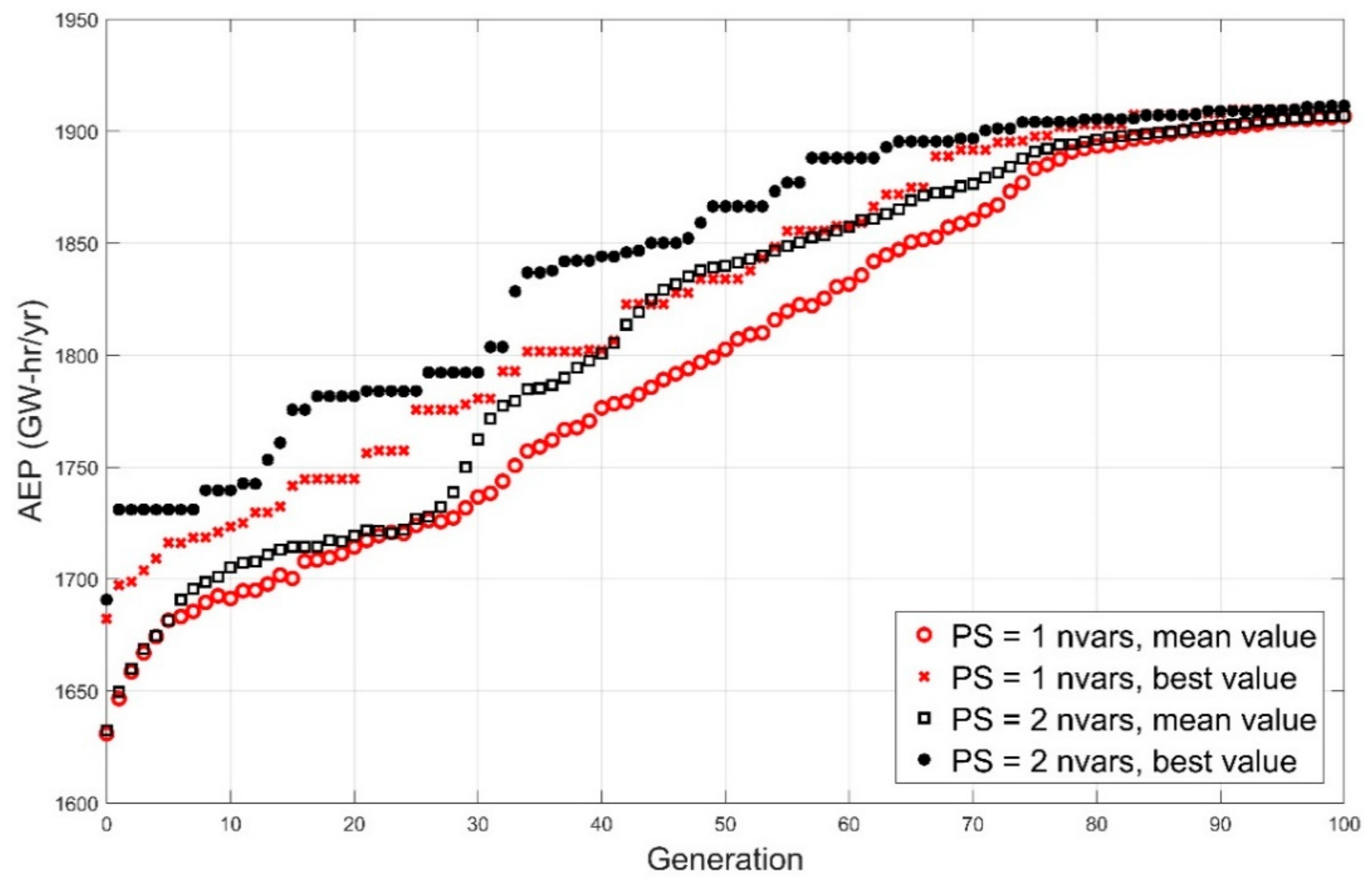
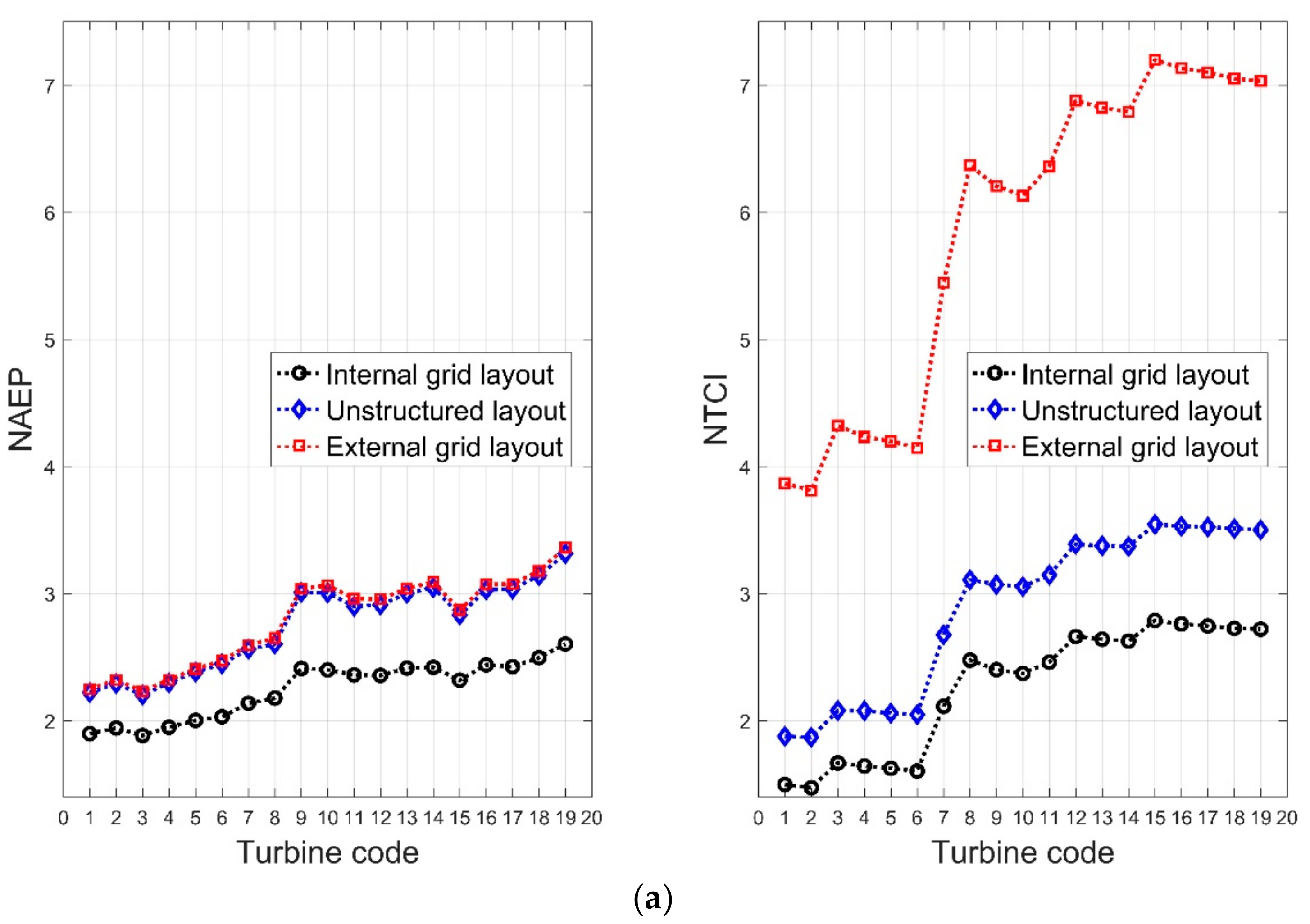
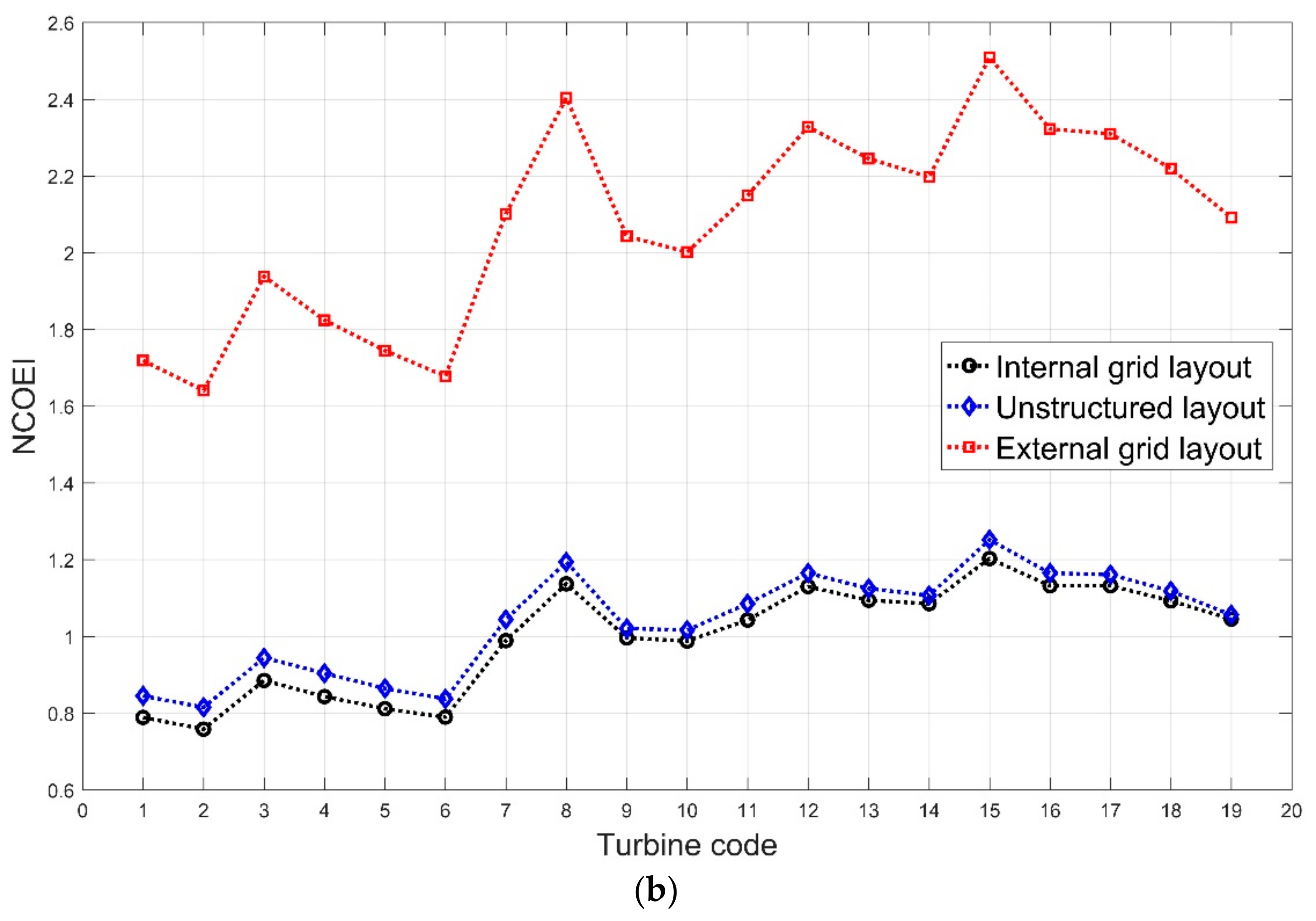
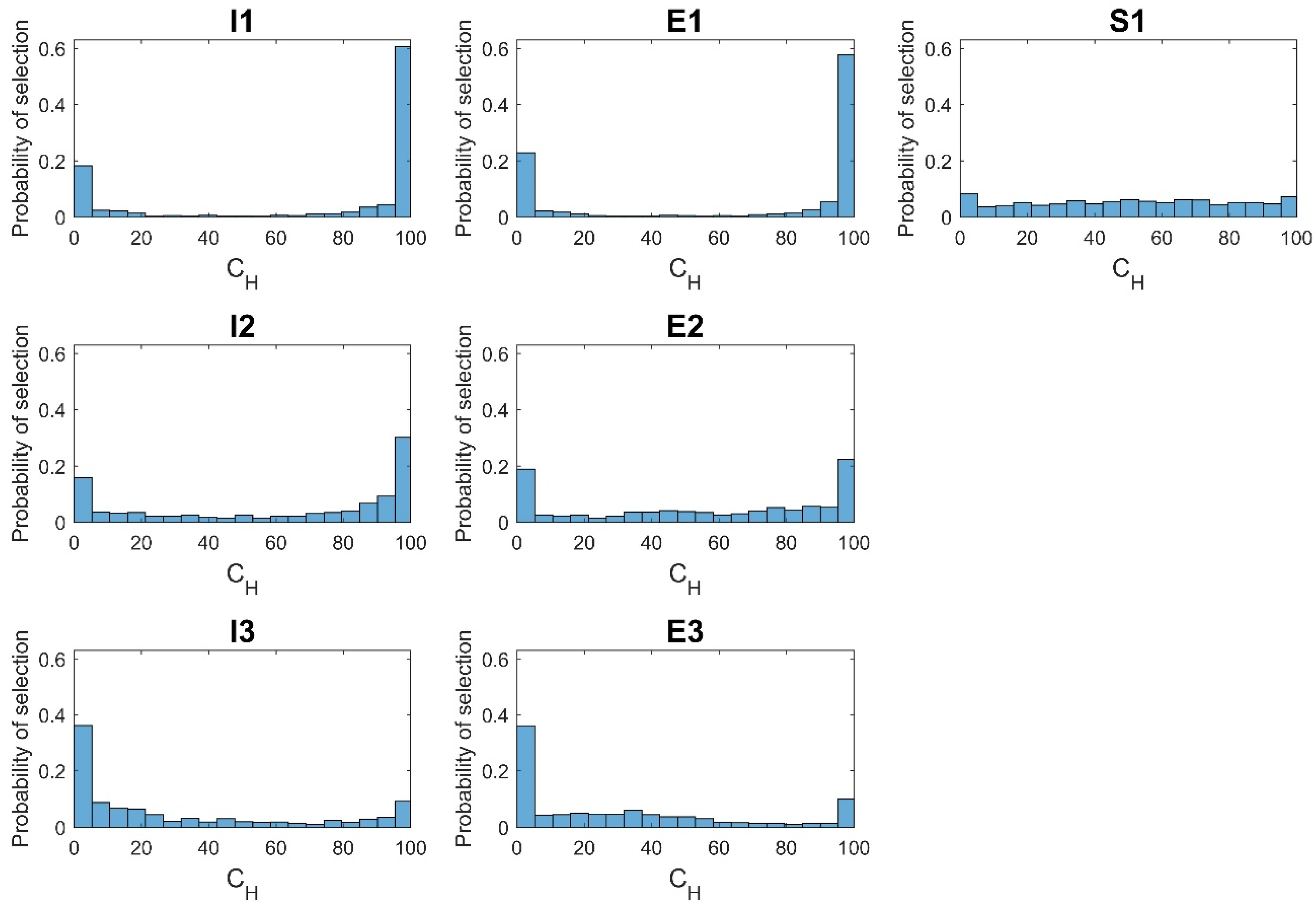

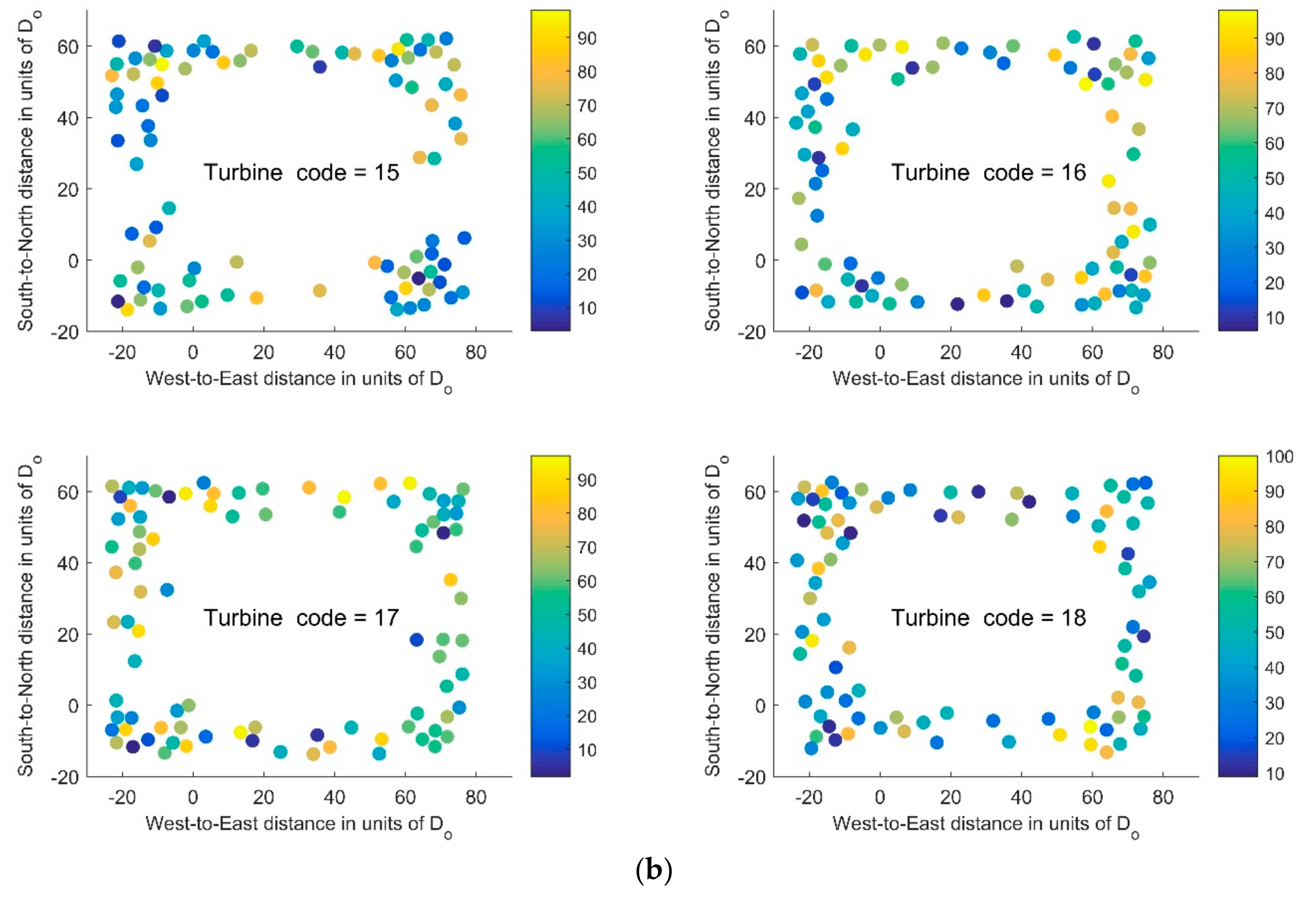
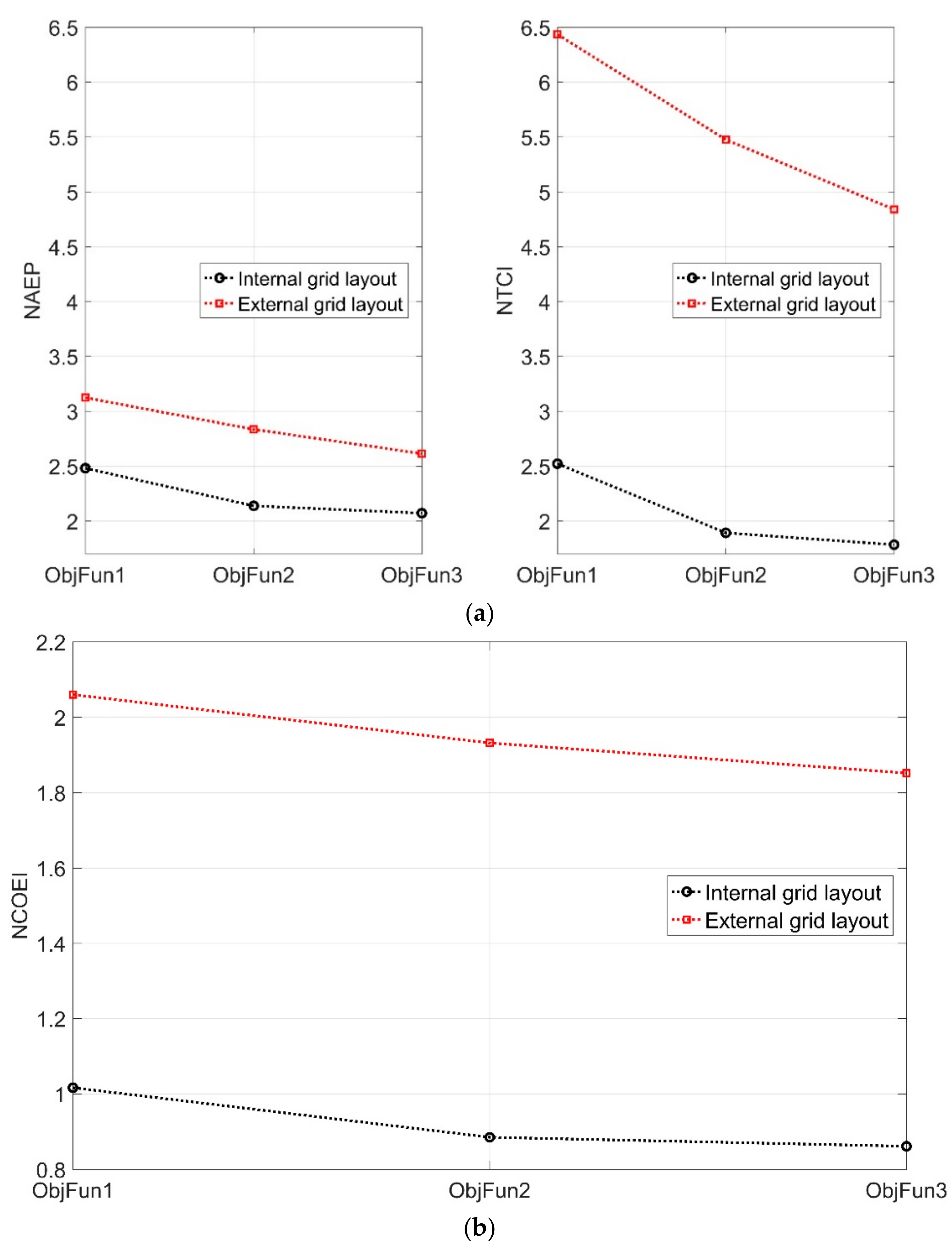
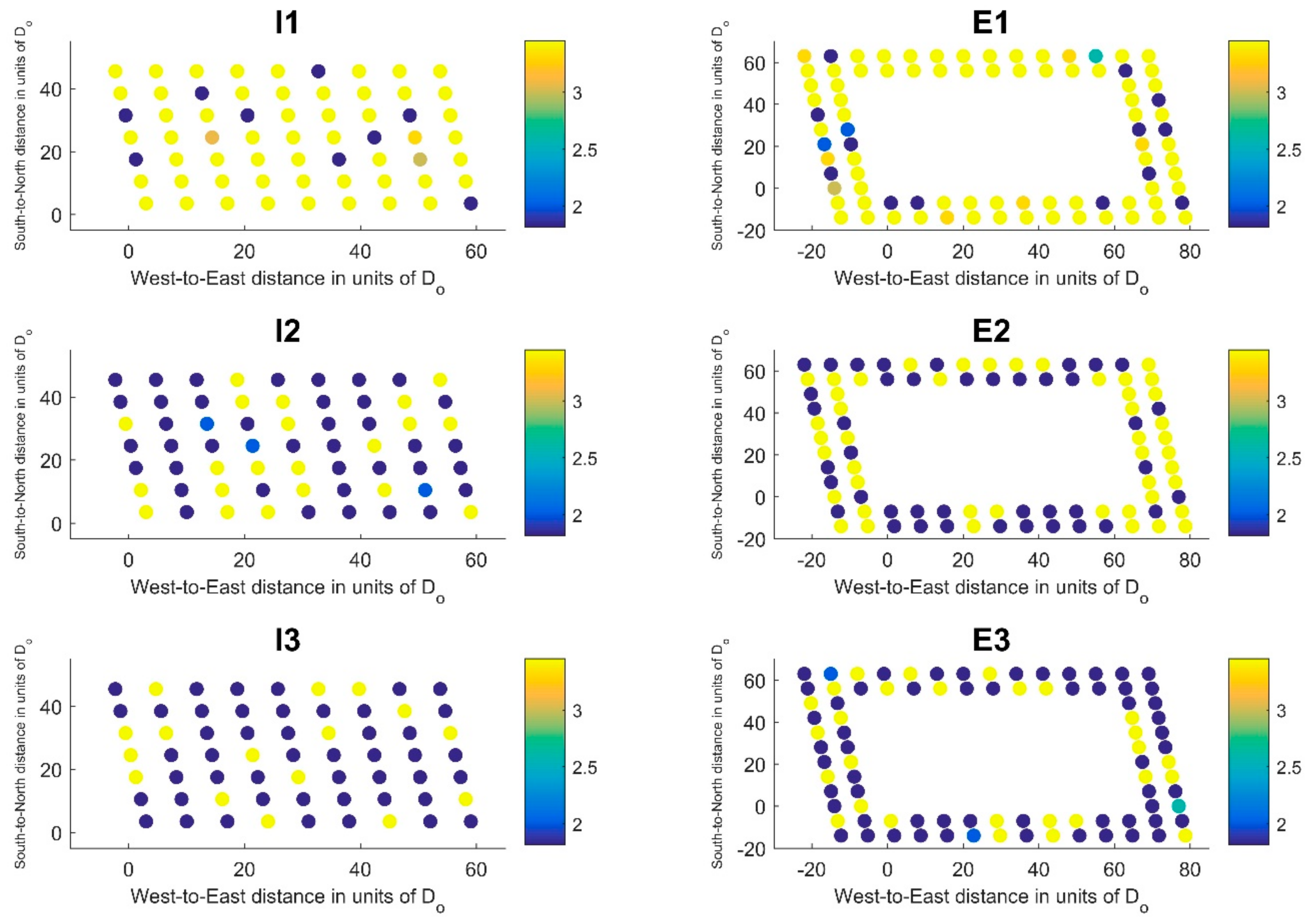

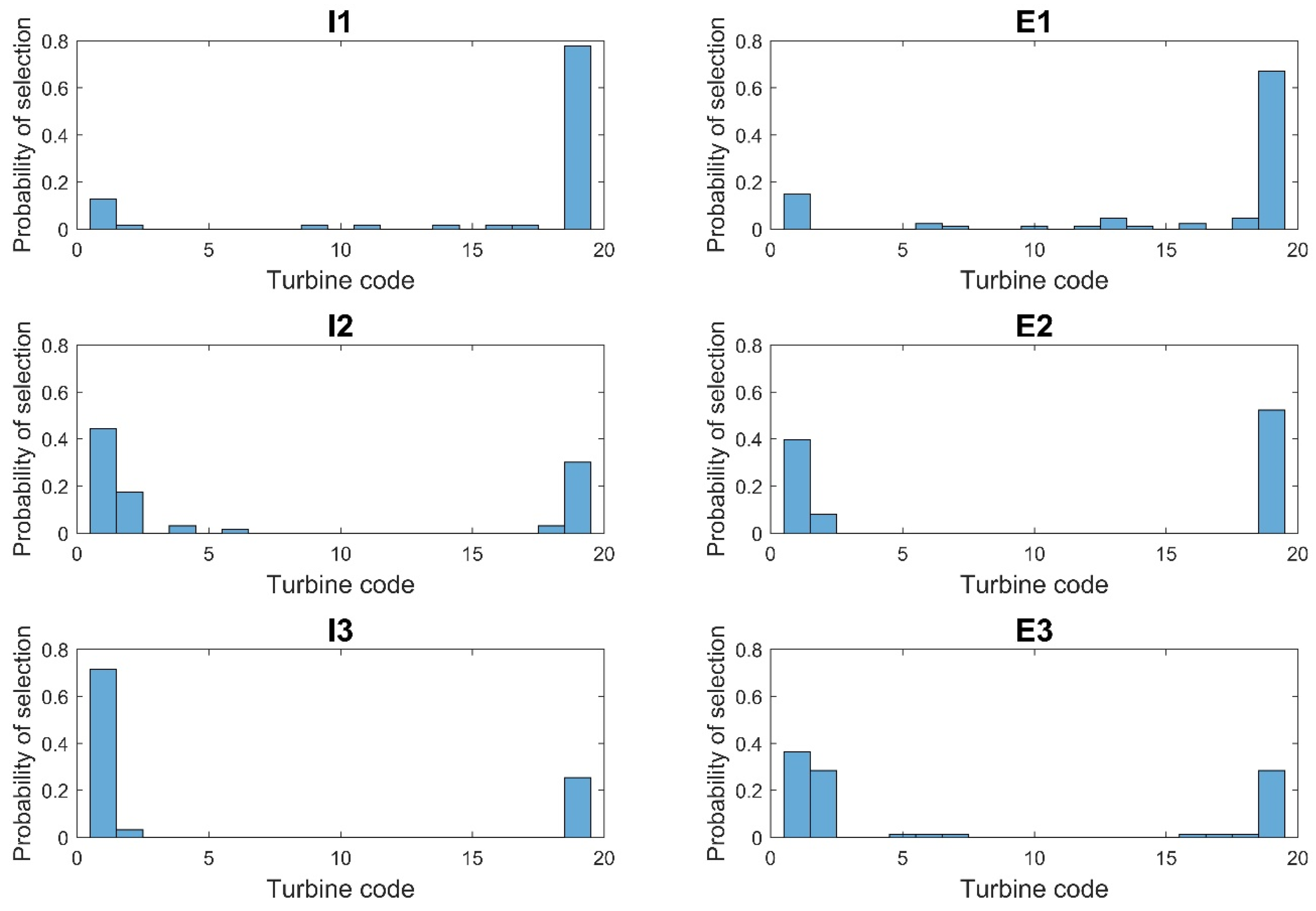


| Turbine Code | Rated Power PR (kW) | Rotor Diameter D (m) | Rated Speed UR (m/s) |
|---|---|---|---|
| 1 | 1815 | 90 | 13 |
| 2 | 1815 | 100 | 11.5 |
| 3 | 2000 | 80 | 14 |
| 4 | 2000 | 90 | 13 |
| 5 | 2000 | 100 | 12 |
| 6 | 2000 | 110 | 11 |
| 7 | 2600 | 100 | 15 |
| 8 | 3000 | 90 | 16 |
| 9 | 3000 | 112 | 12 |
| 10 | 3000 | 126 | 10.5 |
| 11 | 3075 | 112 | 13 |
| 12 | 3300 | 105 | 13.5 |
| 13 | 3300 | 112 | 12.5 |
| 14 | 3300 | 117 | 13 |
| 15 | 3450 | 105 | 13.5 |
| 16 | 3450 | 112 | 12.5 |
| 17 | 3450 | 117 | 11.5 |
| 18 | 3450 | 126 | 11.5 |
| 19 | 3450 | 136 | 11 |
| ObjFun# | Objective | Equation |
|---|---|---|
| ObjFun1 | max AEP | (10) |
| ObjFun2 | min COAEI | (16) |
| ObjFun3 | min COTEI | (17) |
| Layout | Design Variable(s) | ObjFun# | Number of Variables (nvars) | |
|---|---|---|---|---|
| Internal grid (I) | single turbine | CH | 1 | M (= 63) |
| multiple turbines | code, CH | 1, 2, 3 | 2M (= 126) | |
| External grid (E) | single turbine | CH | 1 | M (= 88) |
| multiple turbines | code, CH | 1, 2, 3 | 2M (= 176) | |
| External unstructured (S) | single turbine | x, y, CH | 1 | 3M (= 264) |
© 2019 by the authors. Licensee MDPI, Basel, Switzerland. This article is an open access article distributed under the terms and conditions of the Creative Commons Attribution (CC BY) license (http://creativecommons.org/licenses/by/4.0/).
Share and Cite
Abdulrahman, M.; Wood, D. Wind Farm Layout Upgrade Optimization. Energies 2019, 12, 2465. https://doi.org/10.3390/en12132465
Abdulrahman M, Wood D. Wind Farm Layout Upgrade Optimization. Energies. 2019; 12(13):2465. https://doi.org/10.3390/en12132465
Chicago/Turabian StyleAbdulrahman, Mamdouh, and David Wood. 2019. "Wind Farm Layout Upgrade Optimization" Energies 12, no. 13: 2465. https://doi.org/10.3390/en12132465
APA StyleAbdulrahman, M., & Wood, D. (2019). Wind Farm Layout Upgrade Optimization. Energies, 12(13), 2465. https://doi.org/10.3390/en12132465






